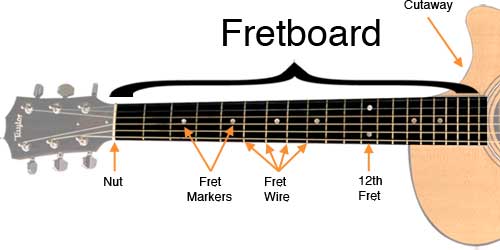Today the pain is slight, but it's still there. Rest rest, but I can't because Jesu sound just so right :)
***end of introduction
SO! This post is about how to read guitar tabs. This comes as a reply to a friend who mentioned that tabs looked complicated. In all fairness, I felt the same way. I still remember how I read a barre chord erroneously, thinking it was impossible to press all 6 strings at once. I thought the barre itself went something like, choose one of the 6 strings. But no! All strings in a barre must be pressed... the biggest shock of my life! I almost wanted to stop playing then. I actually hate barring because it's painful and tiresome to play. Nakakangawit. But it can't be helped. Two of the major chords are played with a barre (F and B). Power chords are in barre (except if the shortcuts are used).
Before starting with chords, here are a few guidelines.
Names of the strings. Yes, they have names. The thickest, the one closest to the player's face when the guitar is at playing position, is called the 6th string. The thinnest is the 1st string. So from the player's point of view, from thickest to thinnest, the string names are: 6th, 5th, 4th, 3rd, 2nd and 1st. Not bad, huh?
Guitar Standard Tuning. The standard notes of each string follows thus: E-A-D-G-B-e. In the absence of an electronic tuner, guitarists can tune the strings by ear (or oido, a music savant who can identify tones by ear), using this nifty site.
 |
| taken from http://www.start-playing-guitar.com/ |
Fret. The parallel lines on the fingerboard that are perpendicular to the strings. When a number precedes the word "fret," this means a particular spot between frets. Markers on the fingerboard help guitarists pick out higher frets with a glance. These are placed in the 3rd, 5th, 7th, 9th and 12th frets.
Left hand finger names. Yes, they have names too! Unfortunately! They are also designated by numbers! They are 1: pointer, 2: middle, 3: ring and 4: pinky.
Open strings. Strings that are played without pressing on the strings. Denoted by the symbol 0 (zero).
Palm mute. Strings that are played muted or not played at all. Denoted by the symbol X.
Reading Guitar Tabs
Let's take the major chord C. This is how it looks like in real life:
 |
| Front view. Taken from http://www.guitar-beginner.com/ |
 |
| Guitarist's point of view. Taken from http://www.1stpersonguitar.com |
Chords are notated in different ways. We'll examine three of the most common types for this exercise.
One of these is the horizontal notation*, like so:
 |
| taken from http://www.pengustudios.com |
This is the easiest to read. This follows the guitarist's point of view, the bottom horizontal line designated by uppercase E being the 6th string and the top horizontal line designated by lowercase e being the 1st string -- remember standard tuning? The leftmost line is the nut (the thickest fret, the leftmost in the fingerboard) and the succeeding vertical lines are the frets. The black spots indicate the points that are to be pressed, and the numbers on the mare the fingers to be used. X means that the 6th string should not be played.
The next notation is vertical*, like so:
 |
| taken from http://www.cyberfret.com |
This one's pretty similar to the previous, except it doesn't follow the guitarist's point of view and the grid lines have been reversed (horizontal lines = frets, vertical lines = strings). Instead of the finger numbers placed inside the black spots, they're placed along the vertical lines. 0 means that these strings are played without pressing the strings, as indicated by the absence of black marks on the respective lines.
Horizontal and vertical notations are used in chord books and playing guides. The following two are called the linear notation*, the root of all complications. These two are favorites among Ultimate-Guitar users, so there's no escaping learning them.
The first one looks like a phone number to some lonely telephone booth. The other looks like a code for some confidential military report. Granted, they don't give as much information as the first two notations, but they're faster to read once the guitarist has mastered the basics.
This notation looks a lot like the vertical notation, doesn't it? Actually, the numbers designate which frets to press, not which fingers to press with. The numbers are also arranged from 6th to 1st string, so that we have 6th string = X, 5th string = 3, 4th string = 2, and so on. For F, the notation would be: 133211, reading 6th = 1st fret, 5th = 3rd fret, 4th = 3rd fret, and so on. Which fingers to press with? That's up to you! Finger names are not indicated, which makes this notation a kind of a level above the first two notations.
This following is causing hyperventilation among newbie users of Ultimate-Guitar, but this is actually highly entertaining to read. This reads like the horizontal notation, except that the numbers designate the frets that must be pressed. Numbers that appear in a single column should be played together. In the notation above, 3 and 0, 2 and 1, and 3 and 3 must be played together, like so:
This notation is played from left to right. The notation above is played so:
3&0 (at the same time) - 0 - 2 - 0 - 2&1 - 0 - 2 - 0 - 3&3. This is Fernando Sor's Study in C (35, 13). This particular part is from 0:06-0:08 of this video. Like the other notations in this post, it's also based on the chord C - see how it uses almost the same fingering as the others, except the notation is fingerstyle.
Questions?
* The terms used here are mine, for ease of narration :)
* Horizontal and vertical notations, referring to the fingerboard position respective to the ground.













